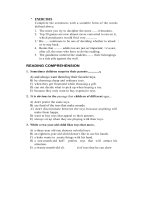Mineral resource classification
Bạn đang xem bản rút gọn của tài liệu. Xem và tải ngay bản đầy đủ của tài liệu tại đây (128.7 KB, 3 trang )
Mineral resource classification is the classification of mineral deposits based on their geologic
certainty and economic value.
A "McKelvey diagram" showing the relationship of mineral resource classifications to economics and geologic
certainty.[1]
Mineral deposits can be classified as:
Mineral occurrences or prospects of geological interest but not necessarily of economic
interest
Mineral resources that are potentially valuable, and for which reasonable prospects
exist for eventual economic extraction.
Mineral reserves or Ore reserves that are valuable and legally and economically and
technically feasible to extract
In common mining terminology, an "ore deposit" by definition must have an 'ore reserve', and
may or may not have additional 'resources'.
Classification, because it is an economic function, is governed
by statutes, regulations and industry best practice norms. There are several classification
schemes worldwide, however the Canadian CIM classification (see NI 43-101), the Australasian
Joint Ore Reserves Committee Code (JORC Code), and the South African Code for the
Reporting of Mineral Resources and Mineral Reserves (SAMREC) [2] are the general standards.
Contents
[hide]
1 Mineral occurrences, prospects
2 Mineral resources
3 Mineral reserves
4 Further information
5 See also
6 References
[edit]Mineral
occurrences, prospects
Main article: mineral exploration
These classifications of mineral occurrences are generally the least important and least
economic. They include all known occurrences of minerals of economic interest, including
obviously uneconomic outcrops and manifestations. However, these are often mentioned in a
company prospectus because of "proximity"; a concept that something valuable may be found
near these occurrences because it has been in the past due to a similar geological environment.
Often, such occurrences of mineralisation are the peripheral manifestations of nearby ore
deposits. "Ore deposit" applies specifically to economic mineral occurrences that could be mined
at a profit after consideration of all factors affecting a mining operation. Note that this distinction
between amounts of raw material available as either a resource or reserve also applies to other
materials considered to be minerals. This can include natural gas (legally defined as a mineral in
some states of the United States) and hydrocarbons.
[edit]Mineral
resources
Mineral resources are those economic mineral concentrations that have undergone enough
scrutiny to quantify their contained metal to a certain degree. None of these resources are ore,
because the economics of the mineral deposit may not have been fully evaluated.
Indicated resources are simply economic mineral occurrences that have been sampled (from
locations such as outcrops, trenches, pits and drillholes) to a point where an estimate has been
made, at a reasonable level of confidence, of their contained metal, grade, tonnage, shape,
densities, physical characteristics[3].
Measured resources are indicated resources that have undergone enough further sampling that a
'competent person' (defined by the norms of the relevant mining code; usually a geologist) has
declared them to be an acceptable estimate, at a high degree of confidence, of the grade,
tonnage, shape, densities, physical characteristics and mineral content of the mineral occurrence.
Resources may also make up portions of a mineral deposit classified as a mineral reserve, but:
Have not been sufficiently drilled out to qualify for Reserve status; or
Have yet to meet all criteria for Reserve status
[3]
[edit]Mineral
reserves
Mineral reserves are resources known to be economically feasible for extraction. Reserves are
either Probable Reserves or Proven Reserves. Generally the conversion of resources into
reserves requires the application of various modifying factors, including:
mining and geological factors, such as knowledge of the geology of the deposit sufficient
that it is predictable and verifiable; extraction and mine plans based on ore models;
quantification of geotechnical risk—basically, managing the geological faults, joints, and
ground fractures so the mine does not collapse; and consideration of technical risk—
essentially, statistical andvariography to ensure the ore is sampled properly:
metallurgical factors, including scrutiny of assay data to ensure accuracy of the
information supplied by the laboratory—required because ore reserves are bankable.
Essentially, once a deposit is elevated to reserve status, it is an economic entity and an asset
upon which loans and equity can be drawn—generally to pay for its extraction at (hopefully) a
profit;
economic factors;
environmental factors;
marketing factors;
legal factors;
governmental factors;and
social factors [4].









